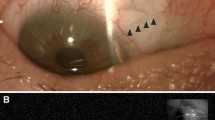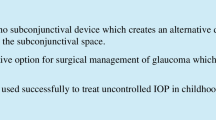Abstract
Purpose
5-Fluorouracil (5-FU) has been well described for a failing trabeculectomy bleb, but not for aqueous shunts. We sought to determine whether subconjunctival 5-FU prolongs the intraocular pressure (IOP) efficacy of Ahmed shunts.
Methods
We included all patients with Ahmed FP-7 implantation by one surgeon at Yale University. Patients with <3 months follow-up were excluded. Injections were done on a case-by-case basis, usually for IOP > 21 on >2 medications. Five-milligram (0.1 cc) injections were made over the plate. The control group consisted of Ahmed FP-7 patients without injections. The main outcome measure was IOP. Secondary outcome was success (IOP <21 mmHg, 20% decrease from preoperative IOP, and no reoperation).
Results
The average age of controls was 72.5 ± 16.6 years, and 63.7 ± 18.8 with 5-FU (p = 0.02). Forty-four patients received 5-FU and 45 did not. Mean preoperative IOP in controls was 31.5 ± 11 mmHg on 3.1 ± 1 medications, and 31.9 ± 9.0 mmHg (p = 0.86) on 3.3 ± 0.9 medications with 5-FU (p = 0.18). At a mean 137 days after surgery, mean pre-injection IOP was 25.3 ± 7.7 mmHg on 2.0 ± 1.3 medications. Five years following implantation, control IOPs averaged 12.9 ± 7.1 mmHg (53% decrease from preoperative IOP, p < 0.001) on 1.4 ± 1.1 medications versus 17.2 ± 4.9 mmHg (46% decrease from preoperative, 32% decrease from pre-5FU IOP, p < 0.001) on 2.7 ± 0.8 medications with 5-FU. The IOP at 5 years was statistically similar in both groups (p = 0.23). Five-year success rates trended higher with 5-FU (77 vs. 67%, p = 0.38).
Conclusions
Subconjunctival injection of 5-FU sustained a significant long-term decline in intraocular pressures in eyes with failing Ahmed shunts. Outcomes between eyes receiving injections and controls were statistically similar.

Similar content being viewed by others

References
Minckler DS, Francis BA, Hodapp EA, Jampel HD, Lin SC, Samples JR, Smith SD, Singh K (2008) Aqueous shunts in glaucoma: a report by the American Academy of Ophthalmology. Ophthalmology 115(6):1089–1098
Lama PJ, Fechtner RD (2003) Antifibrotics and wound healing in glaucoma surgery. Surv Ophthalmol 48(3):314–346
Cantor L, Burgoyne J, Sanders S, Bhavnani V, Hoop J, Brizendine E (1998) The effect of mitomycin C on Molteno implant surgery: a 1-year randomized, masked, prospective study. J Glaucoma 7(4):240–246
Irak I, Moster MR, Fontanarosa J (2004) Intermediate-term results of Baerveldt tube shunt surgery with mitomycin C use. Ophthalmic Surg Lasers Imaging 35(3):189–196
Ghoneim EM, Abd El Hameed M (2011) Needling augmented with topical application of mitomycin C for management of bleb failure. J Glaucoma 20(8):528–532
Dalvi R, Orzech N, Kranemann C, Birt CM (2012) Five-year results of 5-fluorouracil augmented needling revision of failing blebs. Ophthalmic Surg Lasers Imaging 43(1):32–38
Shin DH, Kim YY, Ginde SY, Kim PH, Eliassi-Rad B, Khatana AK, Keole NS (2001) Risk factors for failure of 5-fluorouracil needling revision for failed conjunctival filtration blebs. Am J Ophthalmol 132(6):875–880
Kapasi MS, Birt CM (2009) The efficacy of 5-fluorouracil bleb needling performed 1 year or more posttrabeculectomy: a retrospective study. J Glaucoma 18(2):144–148
Ung CT, Von Lany H, Claridge KG (2003) Late bleb needling. Br J Ophthalmol 87(11):1430–1431
Gracia Garcia-Miguel T, Gutierrez Diaz E, Montero Rodriguez M, Sarmiento Torres B (2002) Management of encapsulated blebs after glaucoma drainage device surgery. Arch Soc Esp Oftalmol 77(8):429–433
Eibschitz-Tsimhoni M, Schertzer RM, Musch DC, Moroi SE (2005) Incidence and management of encapsulated cysts following Ahmed glaucoma valve insertion. J Glaucoma 14(4):276–279
Chen PP, Palmberg PF (1997) Needling revision of glaucoma drainage device filtering blebs. Ophthalmology 104(6):1004–1010
Thieme H, Choritz L, Hofmann-Rummelt C, Schloetzer-Schrehardt U, Kottler UB (2011) Histopathologic findings in early encapsulated blebs of young patients treated with the Ahmed glaucoma valve. J Glaucoma 20(4):246–251
Nouri-Mahdavi K, Caprioli J (2003) Evaluation of the hypertensive phase after insertion of the Ahmed Glaucoma Valve. Am J Ophthalmol 136(6):1001–1008
Molteno AC, Fucik M, Dempster AG, Bevin TH (2003) Otago Glaucoma Surgery Outcome Study: factors controlling capsule fibrosis around Molteno implants with histopathological correlation. Ophthalmology 110(11):2198–2206
Tsai JC, Johnson CC, Dietrich MS (2003) The Ahmed shunt versus the Baerveldt shunt for refractory glaucoma: a single-surgeon comparison of outcome. Ophthalmology 110(9):1814–1821
Ishida K, Netland PA, Costa VP, Shiroma L, Khan B, Ahmed II (2006) Comparison of polypropylene and silicone Ahmed Glaucoma Valves. Ophthalmology 113(8):1320–1326
Ayyala RS, Harman LE, Michelini-Norris B, Ondrovic LE, Haller E, Margo CE, Stevens SX (1999) Comparison of different biomaterials for glaucoma drainage devices. Arch Ophthalmol 117(2):233–236
Christakis PG, Tsai JC, Kalenak JW, Zurakowski D, Cantor LB, Kammer JA, Ahmed II (2013) The Ahmed versus Baerveldt study: three-year treatment outcomes. Ophthalmology 120(11):2232–2240
Feldman RM, el-Harazi SM, Villanueva G (1997) Valve membrane adhesion as a cause of Ahmed glaucoma valve failure. J Glaucoma 6(1):10–12
Patel S, Pasquale LR (2010) Glaucoma drainage devices: a review of the past, present, and future. Semin Ophthalmol 25(5-6):265–270
Ayyala RS, Duarte JL, Sahiner N (2006) Glaucoma drainage devices: state of the art. Expert Rev Med Devices 3(4):509–521
Freedman J, Goddard D (2008) Elevated levels of transforming growth factor beta and prostaglandin E2 in aqueous humor from patients undergoing filtration surgery for glaucoma. Can J Ophthalmol 43(3):370
Shah AA, WuDunn D, Cantor LB (2000) Shunt revision versus additional tube shunt implantation after failed tube shunt surgery in refractory glaucoma. Am J Ophthalmol 129(4):455–460
Palmiero PM, Mehta S, Tello C, Sbeity Z (2010) Tube dislodgement of an Ahmed drainage implant following needling revision of an encapsulated bleb. Can J Ophthalmol 45(2):181–182
Author information
Authors and Affiliations
Corresponding author
Ethics declarations
Funding/support
Supported in part by an unrestricted departmental grant from Research to Prevent Blindness, Inc., New York, NY (JCT). The sponsor had no role in the design or conduct of this research.
Financial disclosures
All authors report no proprietary or commercial interest in any product or concept discussed here.
Ethical approval
All procedures performed in studies involving human participants were in accordance with the ethical standards of the institutional and with the 1964 Helsinki Declaration and its later amendments. As this was a retrospective study, the IRB did not require formal consent.
Conflict of interest
All authors certify that they have no affiliations with or involvement in any organization or entity with any financial interest (such as honoraria, educational grants; participation in speakers’ bureaus; membership, employment, consultancies, stock ownership, or other equity interest; and expert testimony or patent-licensing arrangements), or non-financial interest (such as personal or professional relationships, affiliations, knowledge, or beliefs) in the subject matter or materials discussed in this manuscript.
Rights and permissions
About this article
Cite this article
Kaplowitz, K., Khodadadeh, S., Wang, S. et al. Use of subconjunctival injections of 5-fluorouracil to rescue and prolong intraocular pressure reduction for a failing Ahmed glaucoma implant. Graefes Arch Clin Exp Ophthalmol 255, 1185–1191 (2017). https://doi.org/10.1007/s00417-017-3649-2
Received:
Revised:
Accepted:
Published:
Issue Date:
DOI: https://doi.org/10.1007/s00417-017-3649-2



